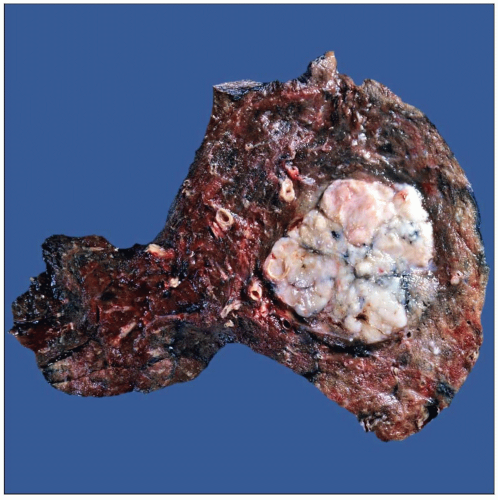Endometrioid-like Carcinoma
Key Facts
Terminology
Malignant epithelial neoplasms with features mimicking secretory endometrium
Clinical Issues
Symptoms
Cough
Dyspnea
Hemoptysis
Chest pain
Prognosis
Depends on clinical and pathological stage
Treatment options
Lobectomy or pneumonectomy
Radiation &/or chemotherapy depending on clinical stage
Top Differential Diagnoses
Pulmonary blastoma: Endometrioid adenocarcinoma
Lacks morular component between glandular structures
Lacks primitive glands that recapitulate lung development of approximately weeks 11-16
Shows intracellular mucin while blastoma lacks it
Metastatic endometrioid adenocarcinoma from gynecologic primary
Differential diagnosis more important in female patients
Clinical history &/or complete physical examination → correct interpretation
Use of immunohistochemical stains may help in some cases
 Gross photograph of an endometrioid-like carcinoma of the lung shows a well-circumscribed but not encapsulated mass. The tumor is light tan and slightly lobulated. |
TERMINOLOGY
Synonyms
Endometrioid adenocarcinoma
Definitions
Malignant epithelial neoplasms that mimics secretory endometrium
CLINICAL ISSUES
Presentation
Cough
Hemoptysis
Difficulty breathing
Chest pain
Treatment
Surgical approaches
Lobectomy or pneumonectomy
Adjuvant therapy
Radiation or chemotherapy depending on clinical stage
Prognosis
Depends on clinical and pathological stage
MACROSCOPIC FEATURES
General Features
Tumor mass is light tan to brown
From 1 cm to > 10 cm in greatest diameter
Hemorrhage or necrosis may be seen
Tumor may be central or peripheral
MICROSCOPIC PATHOLOGY
Histologic Features
Glands composed of cells with clear cytoplasm mimicking secretory phase of endometrium
Absence of morular component
Neoplastic cells with intracellular mucin
Predominant Pattern/Injury Type
Glandular
Predominant Cell/Compartment Type
Epithelial, glandular
DIFFERENTIAL DIAGNOSIS
Pulmonary Blastoma
Endometrioid adenocarcinoma
Lacks morular component between glandular structures
Lacks primitive glands that recapitulate lung development of approximately weeks 11-16
Shows intracellular mucin while blastoma lacks it
Metastatic Endometrioid Adenocarcinoma from Gynecologic Primary
Differential diagnosis more important in female patients
Clinical history &/or complete physical examination are of utmost importance
Use of immunohistochemical stains may help in some cases
TTF-1 may be positive in a small number of primary endometrial adenocarcinomas
DIAGNOSTIC CHECKLIST
Stay updated, free articles. Join our Telegram channel

Full access? Get Clinical Tree




